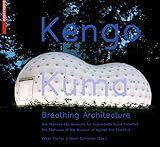Kengo Kuma – Breathing Architecture : The Teahouse of the Museum of Applied Arts Frankfurt / Das Teehaus des Museums für Angewandte Kunst Frankfurt / hrsg. von Volker Fischer, Ulrich Schneider.
Material type: TextPublisher: Basel : Birkhäuser, [2012]Copyright date: ©2008Description: 1 online resource (132 p.)Content type:
TextPublisher: Basel : Birkhäuser, [2012]Copyright date: ©2008Description: 1 online resource (132 p.)Content type: - 9783764387877
- 9783034609586
- 720.92 23
- NA1559.K77 A4 2008eb
- online - DeGruyter
| Item type | Current library | Call number | URL | Status | Notes | Barcode | |
|---|---|---|---|---|---|---|---|
 eBook
eBook
|
Biblioteca "Angelicum" Pont. Univ. S.Tommaso d'Aquino Nuvola online | online - DeGruyter (Browse shelf(Opens below)) | Online access | Not for loan (Accesso limitato) | Accesso per gli utenti autorizzati / Access for authorized users | (dgr)9783034609586 |
Frontmatter -- Inhalt -- Greetings / Grußwort -- Acknowledgement / Danksagung -- Foreword / Vorwort -- What is a Teahouse? / Gedanken zum Teehaus -- Breathing Architecture – Building for Nomads? / Breathing Architecture – Baukunst für Nomaden? -- Designing with Air – Pneumatic Structures in Architecture, Design, Art and Fashion / Mit Luft gestalten – pneumatische Konstruktionen in Architektur, Design, Kunst und Mode -- Japanese and German Sense of Space / Japanisches und deutsches Raumgefühl -- Collaboration in Architecture / Architektur als Zusammenarbeit -- Modern Teahouse: Form – Structural Analysis – Detail / Modern Teahouse: Form – Statik – Detail -- Teatime -- The Teahouse of the Museum of Applied Arts Frankfurt – Picture Documentation / Das Teehaus des Museums für Angewandte Kunst Frankfurt – Bilddokumentatio -- Biographies, Works and Projects / Biografien, Bauten und Projekte -- Illustration Credits/Bildnachweis
restricted access online access with authorization star
http://purl.org/coar/access_right/c_16ec
Der international renommierte japanische Architekt Kengo Kuma hat für den Park des Museums für Angewandte Kunst in Frankfurt am Main ein vollkommen neuartiges Teehaus entwickelt: eine luftgetragene Form. Durch ein Kompressorsystem aktiviert, erwächst das Teehaus wie eine Blüte aus dem semitransparenten High Tech-Material GORE-Tenara, im Inneren finden Tatami-Matten, ein elektrisch beheizbarer Herd für den Wasserkessel, eine Tokonoma Nische und ein Vorbereitungsraum Platz. Die doppelwandige Hülle mit inneren Koppelseilen erzeugt eine golfballähnliche Membrantextur und macht zudem eine Luftschleuse überflüssig. Eine integrierte LED-Technik lässt das Teehaus im Dunklen sanft, fast mythisch, erstrahlen. Dieses jüngste Projekt Kumas ist ein Symbol für die traditionsbewusste Modernität des heutigen Japans und seiner Architektur, aber auch ein richtungsweisendes Beispiel temporären und mobilen Bauens, das nur Dank einer ungewöhnlich dichten internationalen Kooperation zwischen Architekten, Ingenieuren und Unternehmen realisiert werden konnte. Das vorliegende Buch entfaltet die technologischen, kulturhistorischen und ästhetischen Aspekte dieser Neuinterpration des japanischen Teehauses.
Kengo Kuma s Teahouse is a masterly reinterpretation of a classical Japanese building type. Delivered in August 2007 for the Park of the Frankfurt Museum of Applied Arts (a Richard Meier Building), Kuma s innovative structure in flexible, semi-transparent, breathing Tenara-Membrane - inflated by means of a pneumatic system to a blossom-like form - houses in the interior the classical elements for Japanese tea ceremony. Integrated LED technology allows the use of the teahouse at night; the interior can be heated by way of the membrane. The monograph, including an original text by Kuma himself, gives an in-depth documentation of this lyrical temporary structure – an outstanding example of ephemeral architecture, combining poetry and technology - with many unpublished sketches, technical plans and with splendid colour photographs.
Mode of access: Internet via World Wide Web.
In German.
Description based on online resource; title from PDF title page (publisher's Web site, viewed 29. Nov 2021)


